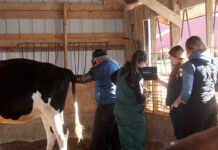HOWARD, Ohio — Some of their family members think they’re crazy, but Greg and Beverly Miller have never looked back since they traded their corporate 9-to-5 jobs for the 24-hours-a-day, seven-days-a-week pace of a farm.
But in the short span since tackling farming full time, the couple has transformed a neglected farm into a well-managed, intensively grazed operation, with a close eye on both the land and their livestock.
The Millers’ Lone Pine Ranch, located in eastern Knox County, was one of five farms selected statewide to receive Environmental Stewardship Awards from the Ohio Livestock Coalition.
Beverly Miller bought the couple’s first 30 acres, house and barn in 1980. The farm sat idle for many years and both land and buildings showed the ravages of neglect. (It was great for growing multiflora rose, Greg jokes.) But the Millers pinned their hopes on this run-down property that now supports them both full-time. They purchased an adjacent 77-acre parcel in 1993.
“We didn’t inherit a farm,” said Beverly Miller, “but we worked off the farm for 20 years so we could do this.”
She has concentrated on the farm full time since 1994; Greg Miller left his accounting job to farm full time in 1997. They bought their first lambs in 1981 and started shipping milk in February 1997.
Currently, the Millers maintain a commercial flock of 130-150 Suffolk/Dorset ewes and milk 28 head of Jersey cows.
All the livestock are rotated through an intensive grazing pasture system.
“We’re a firm believer in grazing,” said Greg Miller. “What the cows won’t eat, the sheep will.”
But, he emphasized, it’s not as easy as turning the animals out on pasture and forgetting about them. “It takes a lot of management,” he said. “We’re still in the learning curve of intensively grazing the cows.”
The Millers have installed above-ground water lines to distant pastures so the animals have access to water in all paddocks.
They’ve also experimented with alternative forages for both the flock and the herd. One of the experiments that proved successful is grazing forage turnips, which will grow chest high. Greg plants two 5-acre plots of Barkant forage turnips for the sheep to graze; the first plot is planted July 1, the second, Aug. 1.
The Millers turn out 60 ewes on the first 5-acre plot and in about 30 days, they’ll eat all the forage. In the next 30 days, the sheep will eat the turnip bulbs, cleaning the field in the process. A second group of 60 ewes gets turned out on the second 5-acre plot. Greg estimates feeding costs of the turnips to be about 7 cents/day/head.
Greg has also liked the milk production results he gets off a fall-planted cereal rye. “The cows love that stuff,” he said.
In addition to what they graze, the milking herd gets balage, a grain mix and ground ear corn, and corn silage that is custom no-till planted and harvested on the Millers’ farm.
The Millers have worked with their local Soil and Water Conservation District and USDA Natural Resources Conservation Service office to establish several conservation practices on their farm.
The farm is an experimental site for two composting projects: a manure composting project and a dead animal composting project.
In 1995, the Millers received financial assistance to design and construct a covered shelter for composting dead livestock up to 500 pounds. The building has three bays and after the material in the first bay decomposes three months, it gets moved to the next bin, and then the next.
When added to the bin, each carcass is surrounded by at least 2 feet of manure from the loose housing barns, which works as a carbon agent and helps minimize odors, Greg said.
The downside is that even when it’s completely decomposed, the material cannot be spread on any of the farmland or vegetable gardens because of concerns of scrapie transmission, Greg said. Scrapie is a fatal, degenerative disease affecting the central nervous system of sheep and goats. It is not transmitted to humans.
Currently, Greg hauls the composted material into their woods.
The Millers are also composting all manure from their barns. The manure is placed in windrows, covered with a unique fleece cover that repels 90 percent of the rain water and yet permits air flow, and then turned every two weeks.
The end product is a very fine, dirt-like soil that Greg Miller spreads through his manure spreader. Working with the SWCD and local OSU Extension office, he’s tested the composted manure content and also calibrated his manure spreader.
“You should know what’s in there, so you know where to apply it,” said Miller, who also bases applications on soil tests.
The conservation-conscious Millers have also installed grassed waterways to reduce soil erosion and have created heavy-use pads in high traffic livestock paths and feeding areas to also reduce erosion.
Having learned so much from others, the Millers are quick to open their farm to visits from local producers, extension groups and university students, according to Knox County Extension Agent Troy Cooper.
“Any time a person strives to balance what is best for the operation, the environment, the livestock and crops, everyone comes out a winner,” Cooper said of the Millers.
Get 4 Weeks of Farm and Dairy Home Delivered









